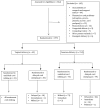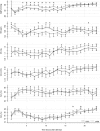Umbilical Cord Milking Versus Delayed Cord Clamping in Preterm Infants
- PMID: 26122803
- PMCID: PMC4485011
- DOI: 10.1542/peds.2015-0368
Umbilical Cord Milking Versus Delayed Cord Clamping in Preterm Infants
Abstract
Background and objective: Delayed cord clamping (DCC) is recommended for premature infants to improve blood volume. Most preterm infants are born by cesarean delivery (CD), and placental transfusion may be less effective than in vaginal delivery (VD). We sought to determine whether infants <32 weeks born by CD who undergo umbilical cord milking (UCM) have higher measures of systemic blood flow than infants who undergo DCC.
Methods: This was a 2-center trial. Infants delivered by CD were randomly assigned to undergo UCM or DCC. Infants delivered by VD were also randomly assigned separately. UCM (4 strippings) or DCC (45-60 seconds) were performed. Continuous hemodynamic measurements and echocardiography were done at site 1.
Results: A total of 197 infants were enrolled (mean gestational age 28 ± 2 weeks). Of the 154 infants delivered by CD, 75 were assigned to UCM and 79 to DCC. Of the infants delivered by CD, neonates randomly assigned to UCM had higher superior vena cava flow and right ventricular output in the first 12 hours of life. Neonates undergoing UCM also had higher hemoglobin, delivery room temperature, blood pressure over the first 15 hours, and urine output in the first 24 hours of life. There were no differences for the 43 infants delivered by VD.
Conclusions: This is the first randomized controlled trial demonstrating higher systemic blood flow with UCM in preterm neonates compared with DCC. UCM may be a more efficient technique to improve blood volume in premature infants delivered by CD.
Trial registration: ClinicalTrials.gov NCT01866982.
Copyright © 2015 by the American Academy of Pediatrics.
Figures


Comment in
-
Does umbilical cord milking result in higher measures of systemic blood flow in preterm infants?Acta Paediatr. 2017 Oct;106(10):1709. doi: 10.1111/apa.13926. Epub 2017 Jun 20. Acta Paediatr. 2017. PMID: 28632316 No abstract available.
References
-
- Committee on Obstetric Practice, American College of Obstetricians and Gynecologists . Committee opinion no. 543: Timing of umbilical cord clamping after birth. Obstet Gynecol. 2012;120(6):1522–1526 - PubMed
-
- Rabe H, Diaz-Rossello JL, Duley L, Dowswell T. Effect of timing of umbilical cord clamping and other strategies to influence placental transfusion at preterm birth on maternal and infant outcomes. Cochrane Database Syst Rev. 2012;8:CD003248. - PubMed
-
- Aladangady N, McHugh S, Aitchison TC, Wardrop CA, Holland BM. Infants’ blood volume in a controlled trial of placental transfusion at preterm delivery. Pediatrics. 2006;117(1):93–98 - PubMed
-
- Strauss RG, Mock DM, Johnson K, et al. . Circulating RBC volume, measured with biotinylated RBCs, is superior to the Hct to document the hematologic effects of delayed versus immediate umbilical cord clamping in preterm neonates. Transfusion. 2003;43(8):1168–1172 - PubMed
-
- McDonnell M, Henderson-Smart DJ. Delayed umbilical cord clamping in preterm infants: a feasibility study. J Paediatr Child Health. 1997;33(4):308–310 - PubMed
Publication types
MeSH terms
Associated data
Grants and funding
LinkOut - more resources
Full Text Sources
Other Literature Sources
Medical

